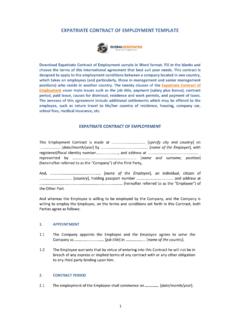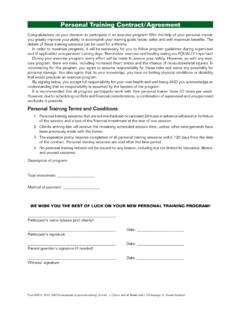Transcription of Model Contract of Employment - NCVO Knowhow
1 Model . Contract OF. Employment . Model Standard Contract 1. Introduction You may have lots of different people contributing to the work of your voluntary organisation or community group. Some may be volunteers, which include members of a management committee, board of trustees or steering group. They will not be paid for their work and only receive the reimbursement of legitimate out-of-pocket expenses. Others may be self-employed, engaged to provide a specific service, such as a builder contracted to repair your premises or an accountant used to audit your annual accounts or a consultant carrying out an evaluation of a project. Occasionally you may have casual workers. For example, you might have a list of people you can call on to fill a gap when someone is off sick or you may have a register of interpreters who you call on to carry out interpreting assignments as and when needed or a pool of cr che assistants to look after children during ESOL classes.
2 The workers can always refuse to do the work and they do not expect you to regularly provide them with work. Work is only offered as and when needed. The workers will have certain rights such as the right to receive the national minimum wage, the right to paid holiday, the right not to be discriminated against. But they are taken on to do work only when required for very brief periods and are not regularly employed. In most cases your staff will be employees whether they work part-time or for a time-limited period (sometimes referred to as temporary or fixed-term). Having employees means that the employer must fulfil certain legal responsibilities. Most paid staff are likely to be employees and so will have certain Employment rights. An example basic Contract of Employment is found on page 6. Model Standard Contract 2.
3 Employment status of your staff Your staff are likely to work a specified time each week. You will have agreed with them the details of the job, ideally confirming this in writing with a signed Contract which lists the terms and conditions. Once the details have been agreed you will expect them to do the work. They cannot turn work down, nor can they select when they want to come in and do the work. They will also expect you to provide them with work on a regular basis. This is known as mutuality of obligation and is a clear indication that your worker is an employee, and not self-employed and not a casual worker. The employer must provide work and the employee must do it. You are also likely to expect your member of staff to deliver specified aims and objectives through their work. This will normally be listed in a job description.
4 You may even tell them how you expect them to undertake their work. It is likely that the staff member will expect to use your equipment paper, pens, computer, books, telephone etc. You will probably not allow them to send a substitute in their place should they not want to do the work themselves. All these aspects clearly indicate that your staff are employees, the most important aspect being mutuality of oligation. An employed person is someone who works under a Contract of service. They are expected to do specified work as instructed by the employer and under the employer's control, such as at particular times at a defined place. The employee expects to be given work. This is called mutuality of obligation: the employer must provide work and the employee must do it. The employee must deliver the work personally and cannot appoint someone else to do it instead.
5 The employee will also normally be integrated into the organisation and will be subject to rules defined by the employer. The employee is likely to use the employer's equipment and resources. The employee will be paid regularly and will not take risks with their own money in carrying out the work. The employee may often work exclusively for one organisation. Model Standard Contract 3. Variation of Contract Remember that: If you intend to use a Model Contract in order to revise or update existing contracts in your organisation (and this includes any procedure that is attached to the Contract such as a disciplinary procedure), you can make changes to existing contractual terms only with the specific written agreement of each employee. You are not entitled to vary contracts unilaterally. The terms of an Employment Contract are those agreed at the outset.
6 The terms can be changed by agreement but there needs to be clear evidence of this. Agreement could be inferred by an employee conforming to the new terms without dispute. An imposed change without acceptance is a breach of Contract . An employee could seek damages for breach if there has been loss or possibly resign and claim unfair constructive dismissal. On the other hand an unreasonable refusal to accept a necessary change may provide grounds for dismissal. If you intend to issue new employees with a new Contract , while maintaining your current Contract for existing employees, think carefully about the implications of having two or more sets of contracts with different terms and conditions. Updating only those terms relating to statutory entitlements (for example, annual leave, maternity, parental or dependants leave) does not require employees' agreement, nor is it necessary to provide detail.
7 It is sufficient to state that the employee is entitled to the statutory provision. Having no written Contract does not mean that there isn't an Employment Contract in place. The organisation should be clear about the existing terms of the Contract before varying them, even if such terms have been previously agreed only verbally or have come about through custom and practice. If the employee and employee agree to any subsequent changes, the details should be written down. Consultation with individual employees is crucial, so that the employer can explain the need for the change and consider Model Standard Contract 4. any concerns. If there are 20 or more employees affected by the proposed changes, collective consultation must also take place with the recognised trade union representative or elected employee representative.
8 The Model Contract is set out below. All policies, procedures and guides mentioned in the Model Contract are available from PEACe. Model Standard Contract 5. PEACe STANDARD Model Contract OF. Employment . This Statement incorporates the minimum statutory requirements and is effective from the first date of Employment , sets out particulars of the terms and conditions of Employment in accordance with the Employment Rights Act 1996 (and as subsequently amended). Throughout this Statement, five working days equals one calendar week. 1. NAME AND ADDRESS OF EMPLOYING ORGANISATION: (hereinafter: "The Organisation" or The Company ). NORMAL PLACE OF Employment : The Organisation may move the normal place of work and you may also be required to work at other locations within _____( Borough(s), Town, etc) from time to time.
9 Note: It is necessary to give the exact location of the employee's workplace, and also important to give details if an employee is expected to work at more than one workplace, or if likely to be moved around. 2. NAME OF EMPLOYEE: (Hereinafter: "You"). 3. DATE OF COMMENCEMENT OF Employment : Note: (i) It is important to record this accurately This is a fixed term Contract . Unless previously terminated your Employment will end on ' If this Contract is a renewal of an old one, for example if the employee has changed jobs within the organisation, you need to note the date of commencement of the original Employment - the date continuous Employment began. Fixed Term Contracts Below are some examples of employees considered to be fixed term under The Fixed-term Employees (Prevention of Less Favourable Treatment).
10 Regulations 2002, and suggested wording to be inserted into their fixed term contracts: (i) Contract for a task: the following clause should be included if the person is being taken on to do a specific time-limited piece of work, for example, a piece of research: This Contract will end on completion of Model Standard Contract 6. [task] . (ii) Temporary Employment : The following clause should be included if the employee is temporary but the end date of the Contract is not certain: This post is not permanent, and your Employment is expected to last for .weeks/months.. (iii) Maternity/Locum Cover: If you are employing a temporary employee to provide maternity or other locum cover (such as parental leave or sickness absence for example) you should insert the following clause: This is a temporary appointment due to the absence on maternity/parental/other leave of the postholder, who is expected to return to work within the next months.







